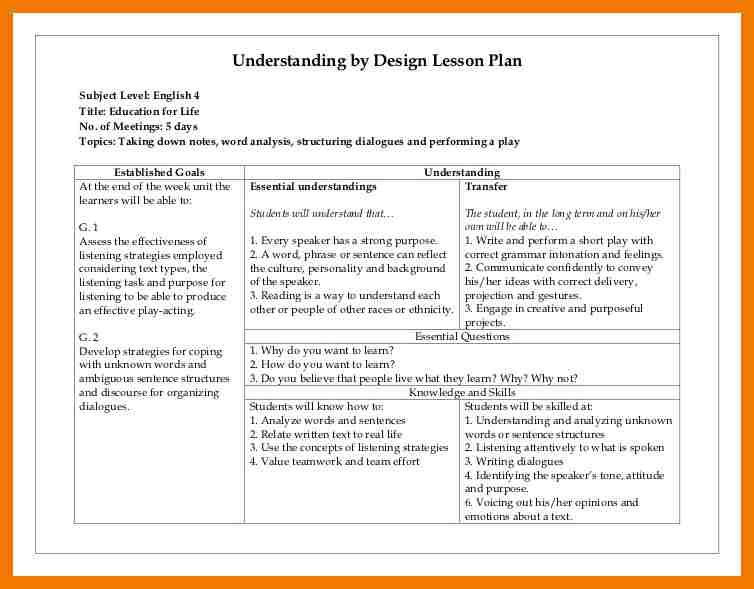Table Of Content
Wiggins and McTighe propose a framework called Six Facets of Understanding as a guide for building effective assessments. It is made up of six non-hierarchical ‘domains’ or ‘facets’ that they identify as indicators of understanding. What students are likely really saying is that they don’t understand how the test reflected the content they thought they studied or learned. Or perhaps they don’t feel they were able to adequately demonstrate what they did learn based on the types of questions they were asked on the exam.
Basic Steps of Backward Design Lesson Plans
You want to treat writing learning outcomes as an iterative process so that you get better and better at it over time. The benefits of backwards design is that each module/chapter sets the stage for the next and clearly shows the learner where they’re headed on their learning journey. This approach also delivers a more impactful and engaging learning experience that is intentional, focused and centered around the learner/student and their needs.
All CFT Teaching Guides
Even outside the traditional educational environment, Backward Design has its place. By acknowledging these theories and the scholars who contributed to them, we not only appreciate the intellectual roots of Backward Design but also understand its strong academic underpinnings. These theories collectively validate why Backward Design is more than a passing trend; it's a research-based, effective approach to education. It would be easy to blow off this distinction, to say Bah, same difference. The test asks students a lot of questions that would show an understanding of these concepts, so we’re covered. No matter your teaching modality, Ohio State has a professional learning program designed to support you with course design.
World Readiness Standards
For your most important learning outcomes, you may need to develop multiple opportunities to measure students' progress over the duration of the course. This will also give students the chance to practice and apply skills in a variety of contexts, incorporate feedback, and get the practice they need to meet upcoming challenges in the course. For these same reasons, your assessment methods will ideally incorporate various degrees of difficulty or skill integration over the semester. When you create your course learning goals, you describe how you want students to change internally as a result of taking your course. Learning goals broadly state what students should know or care about by the end of a course or curriculum. Set aside specific content—remember, that comes toward the end of the backward design process—and think about the big-picture, lasting impact you want your course to have on students.
As teachers, we are left scratching our heads, wondering how in the world students’ substantial content knowledge flitted out of their brains when the bell rang. Or worse, we confidently send students on to another class or grade, sure in their knowledge of our subject only to find out they seem to have forgotten everything we taught them. There is no prescribed minimum or maximum desired results for any unit. Just be aware that you will need to infuse each and every one of them into various lessons throughout the unit. So if you only have a week to run through World War I don’t attempt to include too many skills; you’re setting yourself and the students up for failure.
In other words, instead of starting with the content or activities, the teacher begins by defining the desired learning outcomes and then designs the curriculum accordingly. Backward design in education is a lesson planning strategy that starts with the final assessment, then asks teachers to build their lessons toward that goal. This differs from transitional lesson design, in which teachers identify content they need to cover, build relevant lessons, then create the final assessment. Backward lesson design encourages teachers to be more intentional about their lesson plans and ensures that they make the best use of class time. Backward design lesson planning is a practical and effective approach to curriculum development and instructional design.
Leadership Initiative for Language Learning (LILL)
At this stage it is important to consider a wide range of assessment methods in order to ensure that students are being assess over the goals the instructor wants students to attain. Sometimes, the assessments do not match the learning goals, and it becomes a frustrating experience for students and instructors. Use the list below to help brainstorm assessment methods for the learning goals of the course. The incorporation of backward design also lends itself to transparent and explicit instruction. If the teacher has explicitly defined the learning goals of the course, then they have a better idea of what they want the students to get out of learning activities. Furthermore, if done thoroughly, it eliminates the possibility of doing certain activities and tasks for the sake of doing them.

Carmen Common Sense: Best Practices
As such, students must have multiple opportunities to practice and apply the specific knowledge and skills they need to perform well on assignments and be successful in your course. Reflect on your assessments of student learning from Step 3 to determine the teaching methods and learning activities that will best support students to succeed. As you backward design your course, you should be planning with all students in mind. Universal Design for Learning (UDL) is a framework for focusing curriculum and course design around the diverse needs of learners. Backward design and UDL are complementary frameworks for course planning, as each are centered on student learning and purposeful, proactive course design. Grant Wiggins and Jay McTighe introduced backward design in their book Understanding by Design.
Create Your Course
For example, if I’m planning a curriculum for losing weight by cutting out sugar, my first step would be to plan out the course curriculum by listing out all the topics related to the subject matter. Then the next step is to bring in the various lessons that fit the topic so that I’m breaking down the topic into sub-topics. Finally, the last step is to develop assignments and or quizzes to evaluate student’s grasp of the material. The challenge with this approach is that traditional design overlooks and neglects the course outcomes and how a student might achieve them resulting in lackluster results and engagement. The following examples are simply suggestions for what creating backward design lesson plans might look like.
Fortunately, using backward design lesson planning is easy once you make a few classes or courses with this philosophy in mind. This is where backward design lesson planning comes in handy – as an instructional design model that helps you cut through the overhwelming task of creating a lesson plan that designing a course based on learner’s neads. Planning starts with defining the learning goal and identifying the central question for the lesson. The second step establishes a definable target, an objective that you can measure. The next step is to determine appropriate assessments to demonstrate success with the objectives in place. The final step is where the educator decides which activities and teaching methods are best suited to achieving the learning goal.
Renowned educator Grant Wiggins, one of the creators of Backward Design, emphasized the value of well-defined learning goals in providing direction to both teaching and learning. When discussing the theoretical foundations of Backward Design, it's impossible to ignore Constructivism. This educational theory was primarily influenced by the works of Jean Piaget, a Swiss psychologist, who introduced these ideas in the mid-20th century. According to Piaget, learning is a process where individuals construct knowledge based on their experiences. Like I did, you probably also have some favorite lessons and activities.
New workshop: Best Practices in University Teaching - The Hub at Johns Hopkins
New workshop: Best Practices in University Teaching.
Posted: Thu, 05 Jan 2017 08:00:00 GMT [source]
The last part of your backward unit design entails planning your lessons and activities, being sure to include all the content and skills needed to successfully complete the formal assessment you created. For language educators, backward design provides a road map as a framework for identifying where the learners are, where they are going, and how they are going to get there. Similar to a GPS navigation system, educators have flexibility in planning with students’ needs and interests in mind by considering multiple pathways for arriving at end goals. Backward Design serves as more than just a tool for curriculum planning; it represents a shift in how we think about education. Instead of starting with what educators want to do, it starts with what students need to learn.
Your answer to this question should provide you with more specific (and measurable ILOs. The traditional approach to education planning, sometimes called "Forward Design," usually starts with content and activities. Teachers first decide what to teach (content), then how to teach it (methods and activities), and finally, how to evaluate learning (assessment).
Critics of backward design express concerns around a potential lack of flexibility in programming. Teachers may fear “teaching to the test” and not enabling authentic learning. Education authorities establish a curriculum in a top-down manner that may not fully address the circumstances in a classroom. Interested in more professional development opportunities for teachers? Explore education courses and certificates at the University of San Diego’s Division of Professional and Continuing Education.

No comments:
Post a Comment